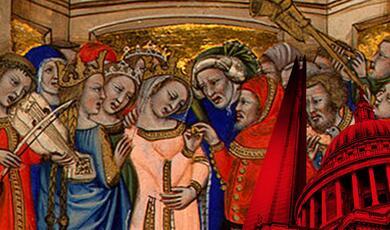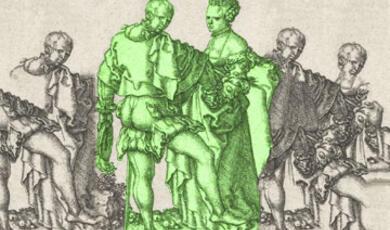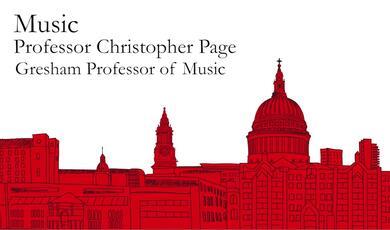What is Noise? Beauty and Taste in 20th Century Music
Share
- Details
- Transcript
- Audio
- Downloads
- Extra Reading
Since the premiere of John Cage’s infamous ‘silent’ work 4’33”, scholars have been fascinated by the question of what noise is, how it differs from music, and whether it can ever be beautiful. Drawing on ideas from musicology and philosophy, this lecture will explore these questions, examining our changing understandings of noise and taste in relation to the shifting socio-political landscape of the 20th century. Ultimately it will seek to question how we experience music in the present day, and discuss whether artistic beauty still has a place at all.
Download Transcript
10 May 2017
What is Noise?
Beauty and Taste in Twentieth-Century Music
Dr Toby Young
Definitions
There are numerous definitions of noise, for example that of an unwanted sound, which is especially loud or unpleasant … a ‘pollutant’. This colloquial description may be demonstrated by various real-world examples, including councils implementing decibel limits, police using loud music or white noise to evacuate buildings and dissipate hostage situations, or even the use noise as torture (e.g. the horrific case of staff at Guantanamo Bay playing children’s songs on repeat to cause extreme psychological effects). Another common description of noise is purely as an acoustic phenomenon, consisting of ‘irregular fluctuations that accompany a transmitted electrical signal but are not part of it and tend to obscure it.’ This questions our relationship with dissonance, and particularly the medieval view of dissonance being anything that did not fit into the natural harmonic sequence (for example the interval of a perfect fourth).
One particular piece of music/art which questions our relationship to these definitions of noise is John Cage’s infamous ‘silent’ piece 4’33”. Through its use of ostensible silence, this piece raises issues about our fundamental notions of noise, and by definition, beauty. Cage posits that ‘if the music can accept ambient sounds and not be interrupted thereby, it’s a modern piece of music’, further claiming that the work is NOT silence (indeed remarking ‘everything we do is music’). This raises interesting questions against the definition of music by Roger Scruton as necessarily requiring melodic content. Cage’s piece is intended to raise awareness of the manner in which sounds in our environment have aesthetic qualities in the same way music does, questioning why we do not appreciate them in day-to-day life.
As an aside, the use of silence occurs throughout music history, with one particularly interesting example coming in the form of the album ‘Sleepify’ by the funk band Vulfpeck. The album did not contain any audible music, consisting only of ten lots of 30-second-long tracks of silence. It was written for the music-streaming platform Spotify, in protest of the low royalty payments offered to artists, with the band encouraging consumers to play the album on a loop while they slept. In return turn, royalties (totalling $20,000) from the playing of each track were to be used to crowd-fund a free concert tour by the band, visiting all the towns that had played the album the most. Interestingly the album was pulled by Spotify on April 26, 2014, citing violations of the service's content policies, suggesting that they very much considered this project to be noise, or at least not music!
This all goes to suggest that noise is at least partly defined by context. There are two main framing functions which help formulate this context: the work-concept (a term developed by musicologist and philosopher Lydia Goehr) where the placing of the piece in various musical contexts through the publishing of scores (etc.) create the notion of a musical work, and the ‘performance-concept’, where the very act of performing a piece of music – whether this be a Beethoven symphony or the nominal ‘performance’ associated with 4’33” – suggested that the piece is worthy of such an endeavour and therefore at least one musician or artist is justifying it as worth being taken seriously as a piece. Typically these ideas suggest some sort of agency has been applied to the music to frame it as a work, through the organisation of sound in some way. An interesting case study which questions this is Thunder by the artist Hannah Rickards, where a recording of an eight-second thunderclap was stretched into a seven-minute passage, then transcribed and arranged into a score for an instrumental ensemble, before the subsequent performance was recorded, and compressed to last eight seconds thereby sounding like the original thunderclap. Whilst the sound of the final product was the same noise as the beginning, the process of creativity and framing (this piece was placed in an art gallery) gives the piece context as an artwork, thereby changing its meaning.
In all of these cases, the use of Language has been particularly crucial to the way we consider and frame these works of art. Every word we use has attached notions of value judgement, creates a context where ‘noise is bad /music is good’. To engage with the linguistic subtlety in this vocabulary, we can look to the idea of a categorical definition. According to the philosopher John Locke, abstract ideas are ‘mixed mode’ concepts, made out of simpler elements. This leads the notion of music being organised sound, however such a definition negates the intention and perception of the musical act. Ludwig Wittgenstein claims that we can extend Locke’s concepts by a ‘family resemblance’ structure, where shared features prevail between objects (or traits), which seems a much more useful linguistic model: where, rather than working with a fixed definition, we compare new cases to existing prototypes to decide whether it should be called music.
Politics, Power and Value Judgement
So then if we are comfortable with this new flexible definition, then most sounds (organised or other) with any mix of context, intent or performative framing could be considered as music. So why might anyone still want to position their work as noise? The philosopher and economist Jacques Attali might have an answer to this, when he says: ‘It is sounds and their arrangements that fashion societies. With noise is born disorder and its opposite: the world. With music is born power and its opposite: subversion … when it becomes music, noise is the source of purpose and power. It is at the heart of the progressive rationalization of aesthetics, and it is a refuge for residual irrationality; it is a means of power and a form of entertainment.’ This echoes the use of the term ‘degenerate’ music (Entartete Musik) by the Nazis, when they wanted to control and even censor certain composers’ music during the Holocaust.
The use of this political situating of music as noise appears in the earlier school of Musique Concrète – a primarily French type of electronic music, which used recordings, and electronics to explore ‘real world’ sounds in the concert hall. Musique Concrète stemmed out of futurist art, with Luigi Russolo suggesting that the industrial revolution gave modern audiences a greater capacity to appreciate more complex sounds than existed already in music. In this case, recorded sounds often attached to labour (e.g. Nono using factory noises in La Fabricca Illuminata) and by playing them in the bourgeois contexts of concert halls, were used to question and even readdress social norms). In this case, the framing of music as noise connotes its social disruption and rebellion.
But now it is important to question whether this view of noise as completely subjective is indeed useful, or even correct. We might want to ask ourselves whether perhaps inherent noise might exist in some form? And if it does, what might it sound like, and whether it changes over time? (like musical dissonance). A useful place to start is in the philosophy of Enlightenment scholar Immanuel Kant. Kant argues that our perception of human experience stems from the structure of the human mind and way we think (e.g. reason is the source of morality, rather than God or another external force). For him, categories of the mind limit our possibilities of experience, because reality must conform to the human mind's active concepts to be conceivable and at all possible for us to experience. Kant therefore believes that aesthetic judgments are fundamentally ‘judgments of taste’, based on an individual’s subjective feelings and the relationship between imagination and perception. In other words, whilst there are qualities inherent in the art-object that make it beautiful and those qualities of the object affect the human subject, it is up to the subject to be receptive (Bowie 2014). For Kant then, beauty is immediately apparent but the sublime – another type of ‘aesthetic experience’ is inconceivable to reason, and therefore holds an air of mystery. Our aesthetic judgment is made with the belief that other people ought to agree with this judgment (an imaginary ‘sensus communis’ or community of taste), even if we know that many will not agree; so beauty (and by default, noise) is fundamentally subjective.
On the other side of this debate sits Georg Wilhelm Friedrich Hegel, whose work aimed loosely to make a scientific and objective study of beauty. In his work Hegel notices a dichotomy between the content and the representation of beauty where ‘we begin with what presents itself immediately to us, and after that go on to consider what is its significance or content.’ He is not concerned with art representing things as they are or how we experience them as sensuous beings. He is more interested in the act of art capturing something of the spiritual essence of nature (humans included). For Hegel, art is a way of representing the Absolute, the absolute spirit and the absolute truth. If a work of art cannot rise to meet the higher spiritual ideal, if it is not significant in any other higher sense other than representation and imitation, it is not art. A fundamental element of the beautiful is something inherent in the object's content (or the Idea), which is the work of art’s truth. When the material reality of art aligns perfectly with the Idea, they merge to become beautiful (the Ideal). Beauty cannot necessarily be understood, but we can objectively experience it; ergo beauty (and by default, noise), is absolute.
Representation and the Gensus Communis
So the logical concluding question is can noise be beautiful in either Kant or Hegel’s eyes? Several examples exist where in popular culture (i.e. the sensus communis) lo-fi is prized as highly beautiful, for example using out-dated equipment such as vinyl to play music, or Jimi Hendrix's use of feedback or distortion in his guitar playing. This is music that challenges the distinction that is made in conventional musical practices between musical and non-musical sound, music that is ‘characterised by the expressive use of noise within a musical context’ (Born 2013), showing an aligning of ideal and representation, which matches up with the Hegalian notion of beauty outlined above. Another example where the sensus communis affects our understanding of expressive noise is in the adoption of forms of MUZAK in ‘high art’. One prominent example is in Brian Eno’s ‘Music for Airports’ (1978), which is a work of ambient Music that explores ‘the products of the various purveyors of canned music’. In it, there is an exploitation of the mundane elements of society, using boredom, meditation, and mindfulness as ways to see through the problems of artifice of objective/collective experience. In other words, ambience is being used as a ‘technology of the self’ (cf. Foucault) to bring us closer to the world around us.
This relationship between us and the world around us is central not only to this discussion, but to art itself. For philosopher and psychoanalyst Jacques Lacan, we spend our whole lives trying to find the Real (or ideal) truth in the world. The Real resists representation, so we can never truly know it. It loses its ‘reality’ once it is symbolized (made conscious) through language, image or sound. As the above example demonstrates, turning the mundane into art is a way of questioning representation in a search for the Real; a manifestation of the ideal/representation dichotomy. Naomi Schor argues, though, that it is the particular, the ‘detail’ which truly shows up the relationship between the artwork and world. She says that especially in Enlightenment, there is a tendency to subsume the detail in favor of the whole. This is primarily due to the preoccupation with science as a way to abstract nature into laws and rules, and with the search for the objective and the true. She says that often the detail is overlooked as decorative and therefore feminine and unnecessary, but in actuality, it accentuates and enables the idea of the whole work of art. In her analysis, Hegel calls these infinite particularities the ‘prose of the world’, yet marks them as wholly insignificant as they contribute little or nothing to the ‘spirit’ of the artwork. She quotes him in his objection to the detail:
But even the portrait painter … must flatter … the purely natural side of the imperfect existence, little hairs, pores, little scars, warts, all these he must let go, and grasp and reproduce the subject in his universal character and enduring personality. It is one thing for the artist to simply imitate the face … and quite another to be able to portray the true features which express the inmost soul of the subject … necessary for the Ideal that the outer form should explicitly correspond with the soul … In case of the human form … the artist does not proceed … like a restorer of old paintings who...reproduces cracks … [instead] the portrait painter will omit folds of skin and, still more freckles, pimples, pock-marks, warts, etc. … Denner, in his so-called “truth-to-nature,” is not to be taken as an example. Similarly, muscles and vein are indicated indeed, but they should not appear in the distinctness and completeness which they have in reality. For in all this there is little or nothing of the spirit, and the expression of the spiritual is essential in the human form.
It is obvious here that Hegel is not concerned with art representing things as they are or how we experience them as sensuous beings. He is more interested in the act of art capturing something of the spiritual essence of nature (humans included). For Hegel, art is a way of representing the Absolute, the absolute spirit and the absolute truth. If a work of ‘art’ cannot rise to meet the higher spiritual ideal, if it is not significant in any other higher sense other than representation and imitation, it is not art. Whereas Kant would place priority on natural beauty over artistic, man-made beauty, Hegel places the spiritual above all, but asserts that it can manifest itself in artistic beauty: “spirit and its artistic beauty stand higher than natural beauty” (Schor 2016, 37). The spiritual and abstract ideal seems to guide much of the Western interpretation of the nature of art. Kant even goes so far as to say ‘aesthetic ideas strive towards something beyond the boundary of experience’, unlocking an element of the world around us.
For Belgian surrealist René Magritte, painting was very much a philosophical act. His paintings present familiar object and scenes in unfamiliar context, forcing the viewer to question the relationship between them. In John Berger’s Ways of Seeing, he cites Magritte as having ‘commented on this always-present gap between words and seeing’. ‘We never look at just one thing’, he says. ‘We are always looking at the relation between things and ourselves’. Magritte’s piece The Collective Invention exposes our relationship with its subject, a fish-woman washed up on shore. Magritte clearly attempts this by reworking common situations in a reality we come to take for granted into events that go ‘beyond’ that boundary, then using them to highlight contradicting relationships between ‘things and ourselves’ in reality. His works puts the viewer in a place of self-reflection and rejects the norm of self-affirmation. The fish-woman in The Collective Invention is lying slack on a beach. She is a perverse reworking of the mythical ideal of mermaids and sirens. The jarring replacement of fins instead of arms and shoulders give the impression that the fish-woman’s arms are tied behind her back. She does not belong on this beach—is literally a fish out of water—and the image seems to suggest that she is trapped here: on the beach as well as in the half-body of a fish. She is imprisoned in the minimized, anti-idealized impression of her. Armless and helpless, the anti-mermaid has not blithely washed ashore by the indifferent sea, but deposited on the sand—not only washed up but used up.
Hegel urges that we find beauty through perfected representation. In art we depict the inmost soul of things as they are and we should not be concerned with minor wrinkles and freckles and imperfections. Magritte doesn’t show the world exactly as we see it or even attempt to represent it as a reality. He doesn’t attempt to capture the “essence” of things or expose their “inmost soul.” Rather, he questions the whole act of seeing. Through paradox and juxtaposition he subverts the reality we take for granted by making what we have come to know as familiar, typical, or cliché become thought-provoking and strange. The Collective Invention's shocking image, like most of his work, makes the viewer uncomfortable. The fish-woman verges on grotesque. It urges the viewer to question their own relationship with the fish-woman and what she represents. It is a surreality we will never precisely have, but instead succeeds in showing the limits of what we see and what is hidden when we look at something. As Magritte himself said, ‘everything we see hides another thing, we always want to see what is hidden by what we see. There is an interest in that which is hidden and which the visible does not show us. This interest can take the form of a quite intense feeling, a sort of conflict, one might say, between the visible that is hidden and the visible that is present’.
Under the modernism, one holds certain truths to be ‘self-evident’, but postmodernism underwrites not only the ‘evidential’ basis for those truths, but the idea that there may be truths at all and operates instead under the subjective. Magritte moves further by subverting that subjectivity (as well as its flaws) come with objectivity. In the postmodern lens all exists within the sphere of the culture and perception; but Magritte seems to questioning even the existence of the lens. Without a common way to see reality, it becomes infinitely more difficult to determine whether we can assert that there is a reality at all. Whether his painting have any extractable ‘true’ meaning is arguable, but the strangeness and the surreality of his pieces effectively conveys flawed natures about the ‘real’ reality. Going back to this issue of noise then, it seems it functions best when, as with Magritte’s work – it is as reflection of society; as uncomfortable as that may be. If art is fundamentally a lens to deal with society in experience of modernity and technology, then noise reflects, reveals and empathises with the complexities and imperfections of the modern world in a necessary and worthwhile way. For philosopher Jean-François Lyotard, the postmodern condition that we live in today is defined by ‘the end of grand narratives or metanarratives’ (such as reductionism and teleological process), which he considers a key feature of modernity. Noise is the ultimate breaking of these ‘grand narratives’, and therefore not something to be shunned or feared, but something to be welcomed!
© Dr Toby Young, 2017
This event was on Wed, 10 May 2017
Support Gresham
Gresham College has offered an outstanding education to the public free of charge for over 400 years. Today, Gresham plays an important role in fostering a love of learning and a greater understanding of ourselves and the world around us. Your donation will help to widen our reach and to broaden our audience, allowing more people to benefit from a high-quality education from some of the brightest minds.


 Login
Login







